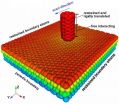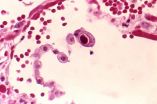Why coffee drinking reduces the risk of Type 2 diabetes
2012-01-13
(Press-News.org) Why do heavy coffee drinkers have a lower risk of developing Type 2 diabetes, a disease on the increase around the world that can lead to serious health problems? Scientists are offering a new solution to that long-standing mystery in a report in ACS' Journal of Agricultural & Food Chemistry.
Ling Zheng, Kun Huang and colleagues explain that previous studies show that coffee drinkers are at a lower risk for developing Type 2 diabetes, which accounts for 90-95 percent of diabetes cases in the world. Those studies show that people who drink four or more cups of coffee daily have a 50 percent lower risk of Type 2 diabetes. And every additional cup of coffee brings another decrease in risk of almost 7 percent. Scientists have implicated the misfolding of a substance called human islet amyloid polypeptide (hIAPP) in causing Type 2 diabetes, and some are seeking ways to block that process. Zheng and Huang decided to see if coffee's beneficial effects might be due to substances that block hIAPP.
Indeed, they identified two categories of compounds in coffee that significantly inhibited hIAPP. They suggest that this effect explains why coffee drinkers show a lower risk for developing diabetes. "A beneficial effect may thus be expected for a regular coffee drinker," the researchers conclude.
INFORMATION:
The authors acknowledge funding from the National Natural Science Foundation of China, the National Basic Research Program of China and the Chinese Ministry of Education.
The American Chemical Society is a nonprofit organization chartered by the U.S. Congress. With more than 163,000 members, ACS is the world's largest scientific society and a global leader in providing access to chemistry-related research through its multiple databases, peer-reviewed journals and scientific conferences. Its main offices are in Washington, D.C., and Columbus, Ohio.
To automatically receive news releases from the American Chemical Society contact newsroom@acs.org.
END
ELSE PRESS RELEASES FROM THIS DATE:
2012-01-13
Nobel laureate poet Rabindranath Tagore once wrote, "Let your life lightly dance on the edges of time like dew on the tip of a leaf." Now, a new study is finally offering an explanation for why small dew drops do as Tagore advised and form on the tips, rather than the flat surfaces, of leaves. It appears in ACS' journal Langmuir.
In the study, Martin E. R. Shanahan observes that drops of water have a preference for exactly where they collect on leaves as their surfaces cool in the morning and afternoon. Those droplets, which condense from water vapor — moisture — in the ...
2012-01-13
Scientists are reporting development and initial laboratory tests of an imaging agent that shows promise for detecting the tell-tale signs of Alzheimer's disease (AD) in the brain — signs that now can't confirm a diagnosis until after patients have died. Their report appears in the journal ACS Medicinal Chemistry Letters.
Masahiro Ono and colleagues explain that no proven laboratory test or medical scan now exists for AD, which is claiming an increasingly heavy toll with the graying of the world's population. Patients now get a diagnosis of AD based on their medical history ...
2012-01-13
Promoting immunizations as a part of routine office-based medical practice is needed to improve adult vaccination rates, a highly effective way to curb the spread of diseases across communities, prevent needless illness and deaths, and lower health care costs, according to a new RAND Corporation study.
Increasingly, vaccinations are being offered outside of physician offices at pharmacies, workplaces and retail medical clinics. Even so, office-based medical practice continues to be central to the delivery of recommended vaccinations to adults.
"Regardless of where vaccines ...
2012-01-13
Similar to the way pavement, softened by a hot sun, will slow down a car, graphene—a one-atom-thick sheet of carbon with wondrous properties—slows down an object sliding across its surface. But stack the sheets and graphene gets more slippery, say theorists at the National Institute of Standards and Technology (NIST), who developed new software to quantify the material's friction.
"I don't think anyone expects graphene to behave like a surface of a three-dimensional material, but our simulation for the first time explains the differences at an atomic scale," says NIST ...
2012-01-13
A new clinical Standard Reference Material (SRM) from the National Institute of Standards and Technology (NIST) will help health care professionals more accurately diagnose and treat cytomegalovirus (CMV), a common pathogen that is particularly dangerous for infants and persons with weakened immune systems.
CMV is found in 50 to 80 percent of the population. It is a member of the herpes family of viruses that includes two herpes simplex viruses (the causes of cold sores and genital herpes), the varicella-zoster virus (the cause of chicken pox and shingles) and the Epstein-Barr ...
2012-01-13
With a random-looking spatter of paint specks, a pair of cameras and a whole lot of computer processing, engineer Mark Iadicola of the National Institute of Standards and Technology (NIST) has been helping the Federal Highway Administration (FHWA), in cooperation with the American Association of State Highway and Transportation Officials (AASHTO), to assure the safety of hundreds of truss bridges across the United States. Iadicola has been testing the use of a thoroughly modern version of an old technique—photographic measurement or "photogrammetry"—to watch the failure ...
2012-01-13
The National Institute of Standards and Technology (NIST), in collaboration with the Centers for Disease Control and Prevention (CDC), has developed two new Standard Reference Materials (SRMs) for measurements of human exposure to environmental toxins. Used as a sort of chemical ruler to check the accuracy of tests and analytic procedures, the new reference materials replace and improve older versions, adding measures for emerging environmental contaminants such as perchlorate, a chemical that the Environmental Protection Agency has targeted for regulation as a contaminant ...
2012-01-13
The chemical industry, which touches 96 percent of all manufactured goods, is seeing some positive signs for 2012, although the overall outlook is not very rosy. Growing demand for chemicals used in agriculture, electronics, cars and airplanes will boost an industry that generates $674 billion in sales in the U.S. alone, but expiring patents and global economic woes will take a toll. These forecasts and others are in the cover story in the current issue of Chemical & Engineering News (C&EN), the weekly newsmagazine of the American Chemical Society, the world's largest scientific ...
2012-01-13
Imagine the following scenarios: a co-worker is spoken to condescendingly, excluded from a meeting, or ignored by a supervisor. How does it make you feel? Do you feel differently depending on whether your co-worker is a man or a woman? According to a new study, workers who witness incivility towards colleagues feel negative emotions – especially when the incivility is aimed at workers of the same sex. The work, by Kathi Miner from Texas A&M University and Angela Eischeid from Buena Vista University, Iowa, is the first to look at the relationship between employees' observations ...
2012-01-13
Astronomers using the partially completed ALMA observatory have found compelling evidence for how star-forming galaxies evolve into 'red and dead' elliptical galaxies, catching a large group of galaxies right in the middle of this change.
For years, astronomers have been developing a picture of galaxy evolution in which mergers between spiral galaxies could explain why nearby large elliptical galaxies have so few young stars. The theoretical picture is chaotic and violent: The merging galaxies knock gas and dust into clumps of rapid star formation, called starbursts, ...
LAST 30 PRESS RELEASES:
[Press-News.org] Why coffee drinking reduces the risk of Type 2 diabetes

